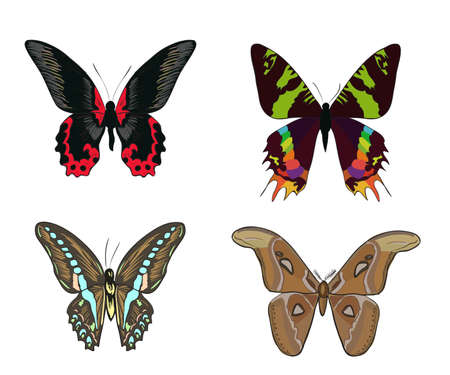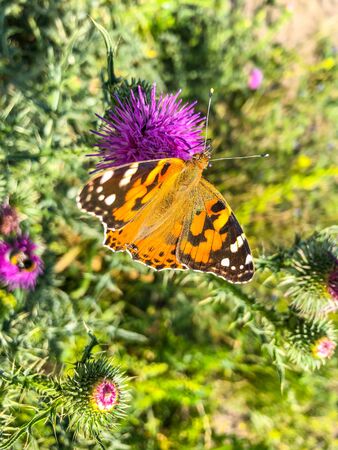Introduction to Wildlife Gardening in the UK
Wildlife gardening has become increasingly popular across the UK as gardeners recognise the vital role their outdoor spaces play in supporting local biodiversity. By choosing native British plants, we not only create beautiful and resilient gardens but also provide essential resources for butterflies and a wide range of beneficial insects. These native species have evolved alongside local wildlife, offering nectar, pollen, shelter, and breeding grounds that non-native plants often cannot match. This approach not only enhances our own enjoyment of nature but also contributes significantly to the conservation of threatened pollinators and natural predators, promoting a healthy and balanced garden ecosystem. As we explore top native UK plants ideal for attracting butterflies and beneficial insects, it is important to appreciate how these choices can transform even the smallest garden into a thriving haven for wildlife.
2. Why Choose Native Plants?
When planning a wildlife-friendly garden in the UK, prioritising native plants is a fundamental step. UK native plants have evolved alongside local butterflies and beneficial insects for thousands of years, resulting in highly specialised relationships. These plants offer nectar, pollen, leaves, and shelter that precisely match the needs of our indigenous pollinators and insect species. In contrast, non-native alternatives often lack these intricate ecological ties, providing less suitable food sources or even becoming invasive.
Benefits of UK Native Plants for Pollinators
| Feature | Native Plants | Non-Native Alternatives |
|---|---|---|
| Nectar & Pollen Availability | Timed to local insect lifecycles; high-quality resources | May not synchronise with pollinator activity; can be less nutritious |
| Habitat Value | Support breeding, shelter, and overwintering for native insects | Often unsuitable as habitat; limited shelter value |
| Ecosystem Impact | Strengthen local food webs; no risk of invasiveness | Can outcompete natives; may disrupt local balance |
Ecological Compatibility
The deep-rooted compatibility between UK flora and fauna means planting native species is more than just a gardening choice – it’s a way to directly support declining butterfly populations and other beneficial insects like hoverflies and solitary bees. For example, many butterfly caterpillars feed exclusively on certain native plants such as nettles or bird’s-foot trefoil, which non-native garden flowers cannot replace.
Sustainable Gardening Practice
Selecting native plants also means less maintenance. They are well-adapted to British soil types and weather patterns, requiring fewer chemical interventions such as fertilisers or pesticides. This approach not only benefits wildlife but contributes to a more resilient, sustainable garden landscape for years to come.

3. Top Native UK Plants for Attracting Butterflies
Creating a haven for butterflies in your garden starts with choosing the right native plants. British butterflies have evolved alongside our local flora, so native species are unmatched in supporting their lifecycle from caterpillar to adult. Below is a selection of outstanding native flowers, shrubs, and trees that have proven highly effective in attracting a variety of butterfly species commonly found across the UK.
Wildflowers
Common Knapweed (Centaurea nigra)
This robust perennial is a magnet for many butterfly species, including Meadow Browns and Marbled Whites. Its purple blooms provide a rich source of nectar throughout the summer.
Bird’s-foot Trefoil (Lotus corniculatus)
Vital for Common Blue and Dingy Skipper butterflies, this low-growing wildflower offers both nectar and larval food. It thrives in lawns, meadows, and even containers.
Field Scabious (Knautia arvensis)
With tall stems topped by mauve pincushion-like flowers, Field Scabious is particularly attractive to Large Whites and Small Tortoiseshells. It flourishes in sunny borders and wild corners.
Shrubs
Purple Loosestrife (Lythrum salicaria)
Best planted in damp areas or near ponds, Purple Loosestrifes vibrant spikes are irresistible to Peacock and Red Admiral butterflies during midsummer.
Buckthorn (Rhamnus cathartica)
This understated native shrub is crucial as a larval food plant for Brimstone butterflies. Planting Buckthorn can help boost populations of this bright yellow butterfly across Britain.
Trees
Goat Willow (Salix caprea)
An early-flowering tree, Goat Willow provides vital nectar for emerging butterflies like the Comma and Small Tortoiseshell in spring, when few other sources are available.
Tip:
When possible, group several individuals of each species together—this makes it easier for butterflies to find them and increases the overall benefit to local wildlife. By prioritising these UK natives, gardeners can support thriving butterfly populations and enjoy a more vibrant, living landscape.
4. Supporting Beneficial Insects Beyond Butterflies
While butterflies often steal the limelight in wildlife gardening, a healthy UK ecosystem depends on a far wider cast of beneficial insects. Bees, hoverflies, and ladybirds are among the unsung heroes essential for pollination, pest control, and maintaining ecological balance. Understanding which native plants support these insects is key for anyone aiming to create a truly biodiverse and sustainable garden.
Key British Beneficial Insects and Their Roles
Each insect group plays a unique part in the garden:
| Insect | Main Benefit | Native Plants They Rely On |
|---|---|---|
| Bumblebees & Solitary Bees | Pollinate fruit, vegetables, and wildflowers | Foxglove (Digitalis purpurea), Common knapweed (Centaurea nigra), Viper’s bugloss (Echium vulgare) |
| Hoverflies | Pollinate; larvae feed on aphids | Cow parsley (Anthriscus sylvestris), Wild carrot (Daucus carota), Yarrow (Achillea millefolium) |
| Ladybirds (Ladybugs) | Aphid control—natural pest management | Nettles (Urtica dioica), Hogweed (Heracleum sphondylium)—host aphids they feed on |
How Native Flora Supports Lesser-Known Insects
The relationship between native flora and beneficial insects is intricate. For example, simple open flowers like those of wild carrot and yarrow offer accessible nectar for short-tongued hoverflies and solitary bees, while nettle patches act as nurseries for aphids that sustain ladybird populations. Avoiding double-flowered cultivars in favour of single, native varieties ensures pollen and nectar remain accessible.
Practical Tips for Supporting Diverse Insect Life
- Mimic natural habitats by planting in drifts and allowing some wild corners to develop naturally.
- Avoid excessive tidiness—dead stems and leaf litter provide overwintering sites for many insects.
- Select a mix of early, mid, and late flowering plants to offer season-long resources.
Towards a Balanced Garden Ecosystem
By diversifying your plant palette with native species that serve both well-known pollinators and these lesser-celebrated allies, you will help maintain the delicate web of life in your patch. This approach not only benefits wildlife but also fosters resilience against pests and promotes thriving gardens across the UK.
5. Design Considerations for Your Wildlife-Friendly Garden
When planning a garden to attract butterflies and beneficial insects, the arrangement and choice of native UK plants are just as vital as the species you select. Here are some practical tips for structuring your garden to maximise its appeal and support for wildlife.
Planting Structure: Layers and Diversity
Incorporate varied heights and plant types by combining tall perennials like Buddleja davidii (commonly called butterfly bush) with lower-growing natives such as Primula vulgaris (primrose) and ground cover like wild thyme. This layered approach mimics natural habitats, providing shelter, basking spots, and easy access to nectar sources for different insect species. Aim to avoid neat, formal rows; instead, group plants in drifts or clusters to create a more inviting environment for pollinators.
Bloom Times: Continuous Foraging Resources
Select a mix of plants that offer flowers from early spring through late autumn. For example, include Pulmonaria officinalis (lungwort) for early blooms, Centaurea nigra (common knapweed) for midsummer colour, and Ivy (Hedera helix) for crucial late-season nectar. Overlapping flowering periods ensure that there is always something available for butterflies, bees, and hoverflies, helping them thrive throughout the year.
Habitat Features: More Than Just Flowers
Diversify your garden with additional features that support insect life. Incorporate patches of long grass, piles of logs, or stone stacks which provide essential shelter and overwintering sites. Leaving some leaf litter undisturbed can also benefit larvae and pupae. Where possible, use local materials such as Cotswold stone or timber offcuts for an authentic British touch.
Tip:
Avoid using pesticides or herbicides—these can harm the very insects you’re hoping to attract. Instead, embrace a slightly wilder look; a few nibbled leaves are a sign your garden is supporting life.
Final Thoughts on Layout
Create sunny spots sheltered from prevailing winds—most butterflies prefer warmth but need protection from strong gusts. Paths winding through your planting beds allow you to observe wildlife up close without disturbing their habitat. By thoughtfully arranging native UK plants and considering the needs of butterflies and beneficial insects at every step, you can transform any outdoor space into a thriving haven for local biodiversity.
6. Sustainable Gardening and Ongoing Care
Creating a haven for butterflies and beneficial insects in your UK garden goes hand-in-hand with adopting sustainable gardening practices. By focusing on the long-term health of your garden, you can maintain vibrant wildlife populations while minimising environmental impact.
Minimal Use of Chemicals
Avoiding or significantly reducing chemical pesticides and fertilisers is essential. These substances can harm not only pests but also the very pollinators and helpful insects you wish to attract. Instead, encourage natural pest control by planting a diverse mix of native species—many beneficial insects will keep pests in check if given the opportunity.
Promoting Healthy Ecosystems
Diversity is key: include a range of flowering periods and plant structures to cater for various insect needs throughout the year. Leave some areas slightly untidy—think log piles, leaf litter, or wild corners—as these provide crucial shelter and overwintering spots for insects. Mulching with organic matter improves soil health and offers habitats for ground-dwelling creatures.
Year-Round Insect Activity
To support insects beyond the peak summer months, select plants that flower at different times—from early spring bulbs like primroses to late autumn asters. Incorporate evergreens and seed heads for winter interest and food sources. Regularly monitor your garden’s health, adjusting care routines as necessary, but always prioritise gentle interventions over drastic measures. By fostering a resilient ecosystem through native planting and mindful stewardship, your garden can buzz with life all year round.


